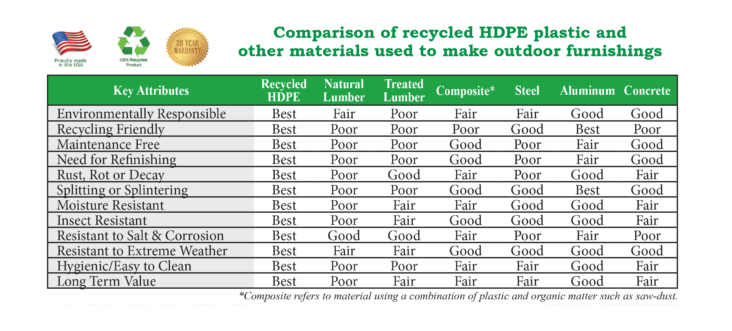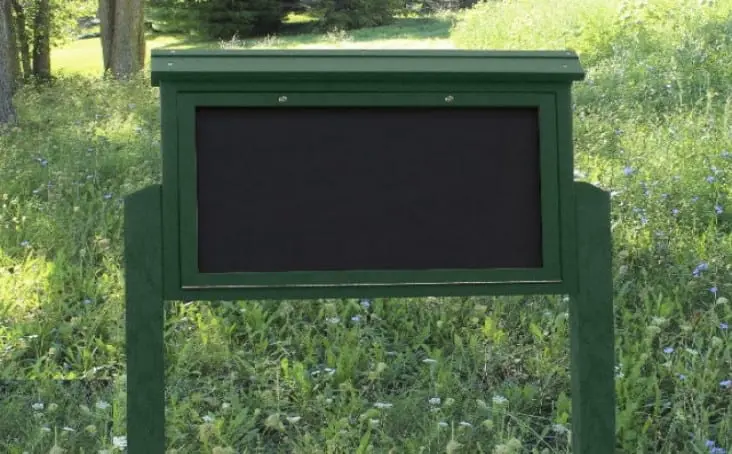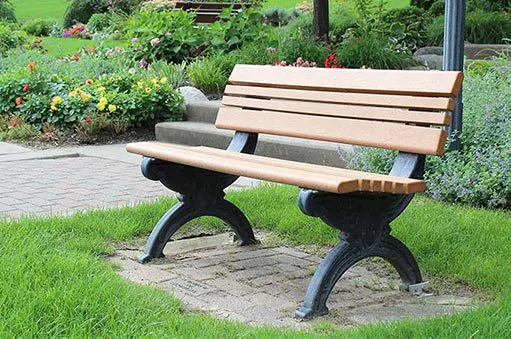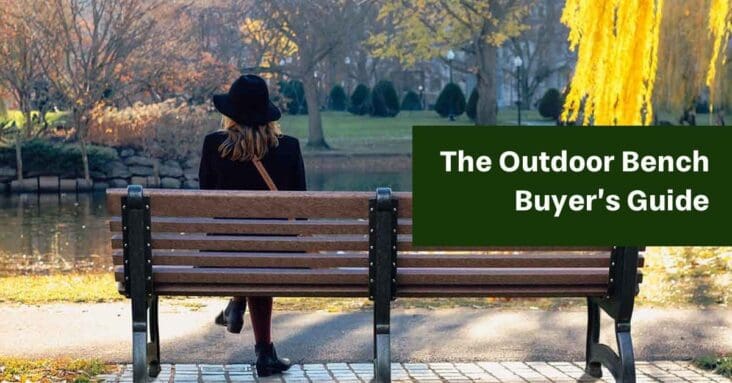

Looking for outdoor bench ideas to set up on your patio? Or maybe in a park or garden? There are many different kinds of outdoor benches to choose from. It is important to pick the right bench in terms of material, size, and design.
When choosing an outdoor bench, consider both the intended environment and your personal style. It’s crucial to pick a design that complements the surroundings while also matching your aesthetic preferences. This two-pronged approach ensures you get a bench that functions well in its designated space while also reflecting your individual taste.
This article will help guide you on selecting the ideal material, size, and design of benches that you can incorporate into any space.
Common Outdoor Bench Materials
Choosing the right material for an outdoor bench is dependent on many factors, the major one being the weather conditions of the intended area. Below are some common materials that can be used for your outdoor bench idea:
Wrought Iron


Wrought iron could be a good choice for an outdoor bench in almost any environment. It brings out a great sense of style in any setting and especially in a home setting. It is durable and can withstand adverse weather conditions such as hot and cold temperature extremes but isn’t a good choice poolside, seaside, or in waterparks.
Wrought iron boasts undeniable beauty, but its charm comes with a demanding maintenance schedule. Moisture is its nemesis, leading to rust and deterioration when paint or coating wears off. While you can remove rust with a wire brush and repaint the affected areas, this approach isn’t ideal. Scraping and sanding release rust and paint particles into the environment, posing a potential health hazard. Additionally, the time and expense of annual maintenance can be a significant burden.
If you’re looking for a never-ending project, wrought iron might be the perfect fit. Its durability ensures it will last for many years. However, be prepared for the ongoing commitment required to keep it looking its best. On the bright side, wrought iron is highly recyclable. So, if you eventually decide to part ways with your bench, it won’t end up in a landfill.
Recycled Plastic
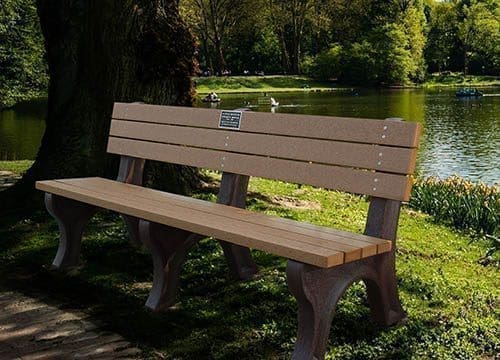

While, at first glance, some recycled plastic doesn’t appear as fancy or classic as its competitors – iron and wood – these products unsurprisingly can last much longer than both. Over time there have been major advancements in recycling technology. If you need a clear example of how recycled plastic can look amazing, take a look at Polly Products recycled plastic outdoor benches. They actualize their bench designs using recycled HDPE #2 plastic to help keep the earth green and reduce the accumulation of plastic waste going to our landfills or waterways. And because #2 plastic is the strongest of all the plastic resins, it’s extremely durable.
Experience the premium difference with Polly’s Products outdoor benches! These recycled plastic wonders offer a long-lasting solution that surpasses traditional options. Say goodbye to mold, pests, and harmful UV rays. Polly benches resist them all, ensuring your bench stays vibrant and beautiful for years to come. Plus, forget about painting, sanding, or finishing. Their maintenance-free design saves you time and money. Built to withstand even the harshest elements, Polly benches use stainless steel hardware that resists rust and corrosion, making them perfect for marine and saltwater environments too. The freedom of placement is yours! Put your Polly bench anywhere you desire, knowing it can handle the conditions.
And for an extra dose of sustainability, rest assured that these benches are made from pure, recyclable plastic. No composites or mixed materials here, meaning they can be recycled again and again after their long lifespan.
Wood


However, wood’s charm comes with a price. It’s susceptible to the elements, readily succumbing to deterioration, rot, splintering, and even pest infestations. This makes it less ideal for harsh outdoor environments exposed to heavy rain, direct sunlight, or extreme temperatures. Even in sheltered areas, regular maintenance like sanding, repainting, or staining is essential to prolong its lifespan. Finally, while wood is a renewable resource, discarded pieces often end up in landfills, raising concerns about its sustainability in the long run.
Wicker resin
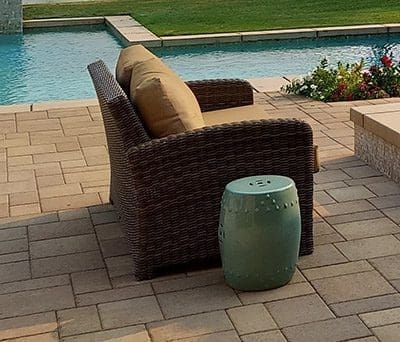

Wicker resin as an outdoor furniture material has become increasingly popular over the years. It is often made from high-quality, recyclable polyethylene and designed to resemble traditional wicker weaving techniques. Wicker resin is a nice choice for outdoor benches; it has natural protection against UV and for this reason, it is resistant to fading, peeling, and cracking. It is fairly durable for household use so you can keep your bench around for a long time.
Additionally, wicker resin furniture is lightweight making it super easy to move around. It does not absorb water; so to keep it clean, hosing it off does the job. This is a particularly good choice if you want an outdoor bench that you can move around with ease. Just remember that being so lightweight means the wind can also move it around. While wicker resin is commonly used in residential patio furniture, it doesn’t offer the same level of strength as solid HDPE plastic. Conversely, commercial outdoor furniture often utilizes more robust versions of heavy, woven resins.
Synthetic wood
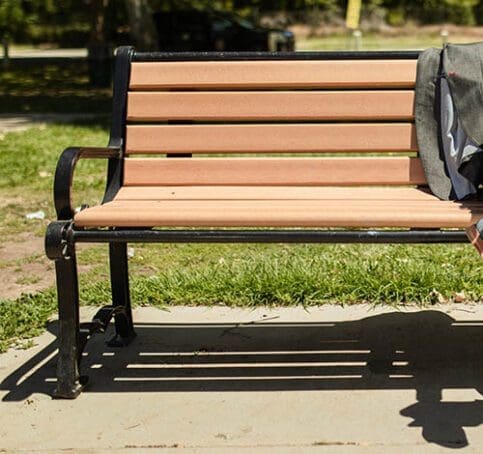

Looking like real wood with its textured and colored grains, synthetic wood is a popular choice for outdoor furniture and decking. Why? It’s a weather warrior, standing up to rain, wind, sun, and snow without breaking a sweat. Unlike natural wood, it requires minimal maintenance to keep it looking its best.
Often called composite wood, its strength, resistance to pests, and water absorption depend on its ingredients. This makes it a versatile and affordable option for your outdoor bench. Plus, it comes in a variety of colors and textures, allowing you to create unique designs.
Remember, longevity, durability, and recyclability depend on the specific composition. While some manufacturers use recycled plastic bags, be wary of mixed materials or organic content. These can hinder the product’s true sustainability, as it might still end up in landfills after its lifespan.
Common Outdoor Bench Sizes & Dimensions
Usually, you can seat three to four people on an outdoor bench. Benches are made to offer extra seating space or a substitute for space-consuming dining tables etc.
Is there a Standard Size Bench?
The space allocated for your outdoor bench should be considered in whichever environment it will be placed in. You can order a bench in a length that will provide the most seating in the space available or one or two smaller benches for a more intimate seating arrangement.
Outdoor Bench Widths
There really isn’t a standard length for outdoor benches but there are guidelines based on the number of people (adults) it can accommodate. You might also consider whether the bench will have armrests, as those will take up space from the seat length.
A bench between 42” and 50” will comfortably seat two people with plenty of room to move. For a three-person bench, look for a bench between 51” and 80”. A bench that’s 81” to 96” has space enough for 4-5 people.
Outdoor Bench Seat Heights and Depths
The seat heights and depths are different depending on the type of bench, such as for young children, school-age kids, or adults. The seat heights and depths will encompass a range in inches that varies significantly depending on the approximate size of the intended user.
For adults, seat heights between 18” to 20” are considered standard. As for the seat depth, 15” to 20” provides a comfortable seat for a backed bench. The depth can be different for flat benches, such as those in locker rooms vs. rest areas in parks and venues.
Outdoor Bench Dimensions
The dimensions of an outdoor bench are heavily dependent on the style and size of your desired bench. The dimensions of an outdoor bench depend on the size and style of the bench. For example, a standard park or garden bench is typically 45 inches long and 12 to 15 inches wide.
The outdoor bench heights can range from 18 to 20 inches depending on preference.
However, benches specifically designed for people with disabilities have a designated height of 17 to 19 inches. In essence, many benches come with armrests which are usually around 10-12 inches in width for added comfort.
Outdoor Bench Design Ideas
There is an endless variety of outdoor bench designs to choose from, depending on your criteria for selection. Discover a world of possibilities with these outdoor bench ideas:
Buddy Benches
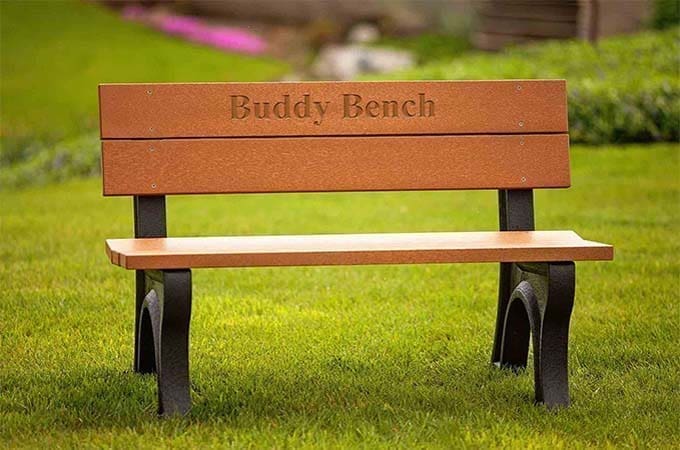

We call them Buddy benches because they are built with the idea of friendship in mind. They are perfect for little kids on playdates and even adults who seek to make conversation and form new connections. A buddy bench can sit two or more people and is ideal for schools, churches, and parks, or playgrounds.
Custom Plaques


It is common practice to use custom plaques and pavers for memorials and custom benches because they can have multiple lines written on them. They as great gifts for occasions that need commemoration, like anniversaries. Custom plaques are also a cheaper alternative to engraving letters on the bench.
Greenscapes
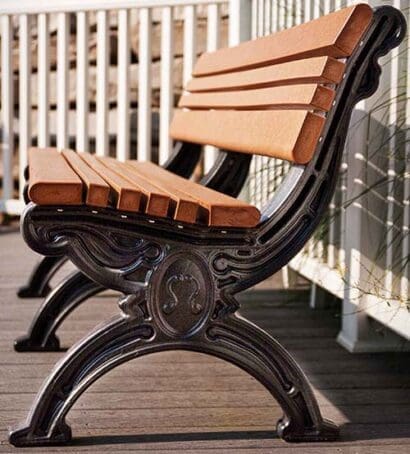

The Greenscapes line is built in alignment with the classic metal frames aesthetic but at Polly Products we use solid recycled plastic to make these frames. They are attractive in any outdoor setting and are safe for all environments in that they are paint free and free from rust. Providing the benefit of wrought iron looks but the longevity and worry-free features of recycled plastic.
Holiday Benches
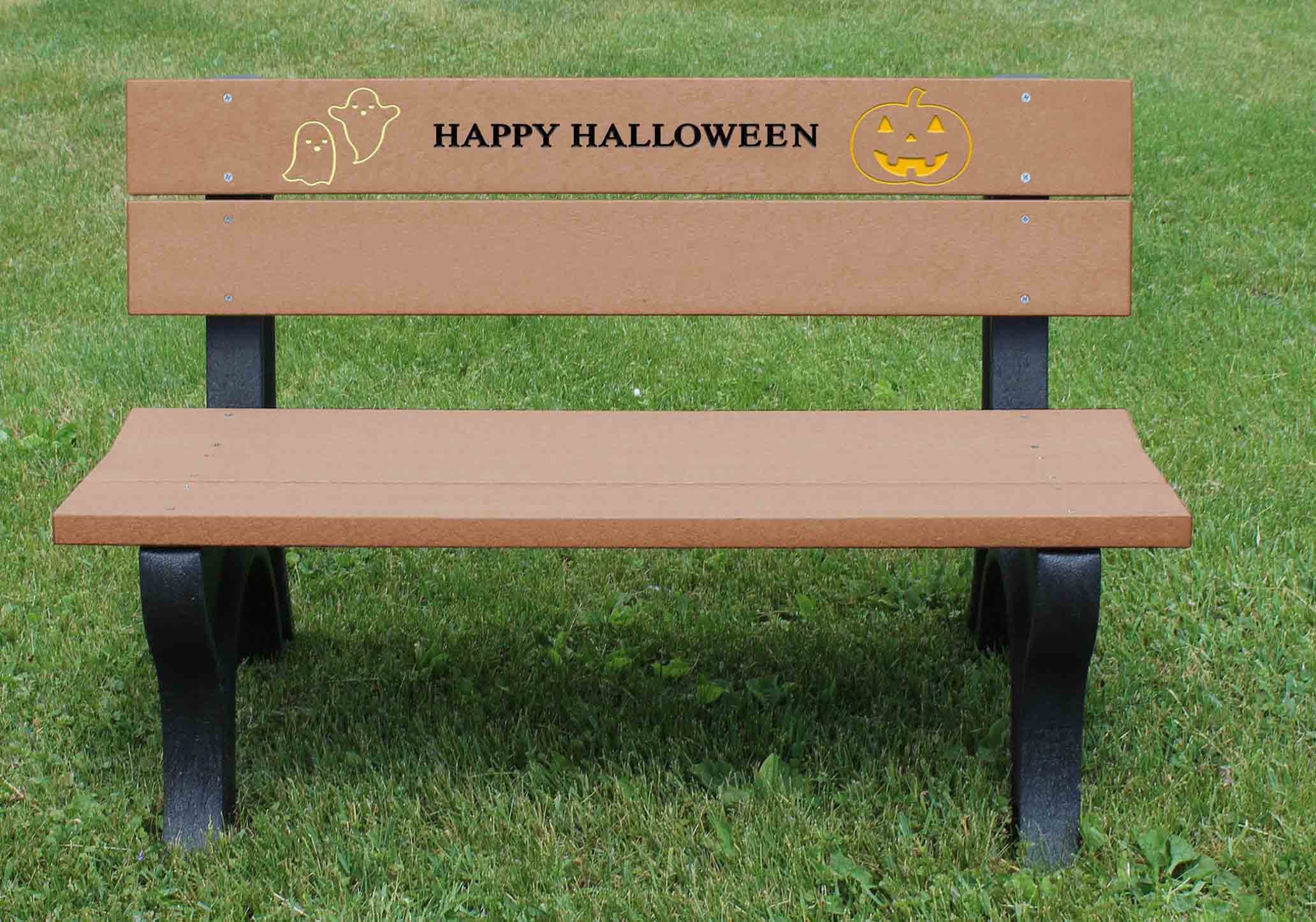

Our holiday custom benches are the perfect idea to spice up your outdoor furniture style. You can customize your holiday benches to be different for each holiday, whether it’s Christmas or Halloween. It gives off a different corresponding feeling during different seasons, which is why it’s a great idea for an outdoor bench at home, in front of your business, or on public grounds like a river trail or park.
Conclusion: The Best Outdoor Bench Materials
Adding an outdoor bench to your space is a great way to class up your home surrounding. For outdoor benches in open spaces such as parks, it is especially important to choose the best materials to achieve both appeal and durability.
Recycled plastic provides the benefits of all other materials at the same time, eliminating their downsides. Not only do they play their role in conserving the environment, but they are also highly cost-effective. Reach out to Polly Products today! They deliver the best, recycled plastic products, and provide you with personalized outdoor bench plans suited to your particular needs!
